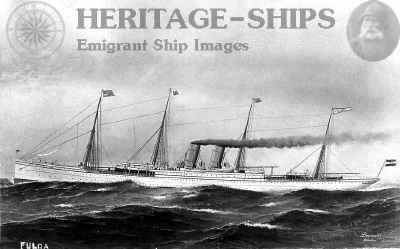The Fulda was an iron screw steamer with a gross tonnage of 5,100. Built for the North German Lloyd of Bremen, the vessel was intended for transatlantic service on the Bremen – New York route, via Havre and Southampton.
The Fulda measured about 450 feet in length, 46 feet in beam, and 36 feet 6 inches in depth. She was classified in the highest grade by Bureau Veritas, with additional reinforcements exceeding standard requirements, including iron lower and orlop decks as well as extra watertight bulkheads. The upper deck was constructed from teak, and all deck structures and fittings were made of either teak or iron.
To improve seaworthiness in harsh Atlantic conditions, robust turtle decks were installed at both the bow and stern. Amidships, the upper deck housed accommodations for officers, firemen, and other crew, along with galleys, a smoking room, and entrances to the first- and second-class saloons. Above this area, a 180-foot-long promenade deck—extending the full width of the vessel—was designated exclusively for first-class passengers.
The Fulda was designed to carry a crew of 170 and offered accommodations for 170 first-class, 90 second-class, and 1,100 third-class (steerage) passengers. Steerage passengers were berthed on the lower deck, while first- and second-class passengers were accommodated on the main deck. The main saloon was located forward of the engine and boiler spaces, following contemporary practice for first-class liners. A prominent feature of the superstructure was a promenade deck, approximately 180 feet long and spanning the full width of the vessel, reserved exclusively for first-class passengers. Crew accommodations, along with galleys, a smoking room, and entrances to both first- and second-class saloons, were located amidships on the upper deck.
The vessel’s interiors were constructed and furnished to an exceptionally high standard. The main dining saloon measured approximately 45 feet square, was illuminated by a central cupola, and was lavishly decorated in the German Renaissance style. It featured intricate wood carvings executed in Glasgow from designs by a German architect employed by the owners. The decorative work included contributions from many prominent firms. Paintings adorning the paneling were completed in Germany, while the upholstery was designed by Archibald Stewart of Union Street, Glasgow. The main staircase, a notable work of carving and decorative artistry, was crafted by Mr. Craig of Glasgow.
Modern lighting was a significant feature of the ship's design. About 200 electric lights, including arc and Swan incandescent lamps, were installed by Mr. B. Miller of Glasgow, supplemented by traditional oil lamps as a secondary system.
The vessel featured four iron pole masts, with yards on the fore and main masts. She was outfitted with a full range of modern equipment, including a steam windlass, steam and manual steering gear, steam winches, hold and navy pumps, a fresh-water condenser, and other innovations aimed at enhancing safety and cargo handling efficiency.
Propulsion was provided by inverted compound engines, also supplied by John Elder & Co., consisting of two low-pressure cylinders (86 inches in diameter) and one high-pressure cylinder (69 inches in diameter), each with a 5-foot stroke. Steam was generated by four double-ended boilers, each equipped with six furnaces. The machinery was expected to produce 6,000 indicated horsepower. The engines were paired with four double-ended Scotch boilers, each measuring 16 feet in diameter and 17 feet 9 inches in length, fitted with corrugated Fox’s furnaces and offering a total heating surface of 17,500 square feet. The steel crankshaft drove a 22-foot diameter manganese bronze propeller with a 30-foot pitch. Circulating water through the condensers was managed by two of Gwynne's centrifugal pumps.
Additional equipment on board included a steam windlass, steam and manual steering gear, steam winches, steam hold and navy pumps, a fresh-water condenser, and expansive cooking facilities supplied by A. Brownlee & Co. of Anderston Quay, designed to cater for both saloon and steerage passengers.
The Fulda was a sister ship to the Werra, which had been launched by the same shipyard in July for the same shipping line. At her launch, the vessel was christened Fulda by Miss Frances Duff of Hillhead. On the trial trip on Fabruary 27th 1883, from Cloch Lighthouse to Corsewall Point and back, the Fulda demonstrated excellent performance. During six hours of continuous operation at 67 revolutions per minute, the engines generated 6,386 indicated horsepower—well above the nominal rating of 1,000 IHP—and achieved an average speed of 17.03 knots.
The Fulda was consequently assigned to the Bremen – New York service via Southampton. She ploughed the ocean back and forth on this route until October 1891, when she was transferred to the Genoa – New York service via Gibraltar. For the Mediterranean service, the Fulda was painted white. The practice of painting passenger steamships white was associated with operations in warmer climates, such as the Mediterranean. This choice was driven by both practical considerations, such as temperature regulation and visibility, and marketing strategies aimed at appealing to passengers seeking comfort and luxury.
In 1899 the Fulda was sold to the Canadian Steamship Company, Limited. While in the in the graving dock at Birkenhead she was literally wrecked when the keel-blocks collapsed under her, After sustaining serious damage the Fulda was deemed beyond repair. On Aug. 17 she was towed from Bremerhaven to Vegesaek to be completely broken up.

Fulda, Norddeutscher Lloyd steamship
Support Norway Heritage: Purchase a copy

Fulda, Norddeutscher Lloyd steamship of the Werra class
Support Norway Heritage: Purchase a copy 
Werra class steamer, Norddeutscher Lloyd - deck plans and sectional view
Support Norway Heritage: Purchase a copy